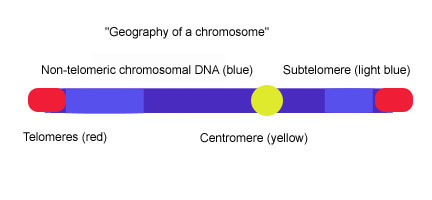
Chromosome regions
Encyclopedia

Virtual
The term virtual is a concept applied in many fields with somewhat differing connotations, and also, differing denotations.The term has been defined in philosophy as "that which is not real" but may display the salient qualities of the real....
regions that exist in all chromosome
Chromosome
A chromosome is an organized structure of DNA and protein found in cells. It is a single piece of coiled DNA containing many genes, regulatory elements and other nucleotide sequences. Chromosomes also contain DNA-bound proteins, which serve to package the DNA and control its functions.Chromosomes...
s.
During cell division
Cell division
Cell division is the process by which a parent cell divides into two or more daughter cells . Cell division is usually a small segment of a larger cell cycle. This type of cell division in eukaryotes is known as mitosis, and leaves the daughter cell capable of dividing again. The corresponding sort...
, the molecules that compose chromosomes (DNA
DNA
Deoxyribonucleic acid is a nucleic acid that contains the genetic instructions used in the development and functioning of all known living organisms . The DNA segments that carry this genetic information are called genes, but other DNA sequences have structural purposes, or are involved in...
and protein
Protein
Proteins are biochemical compounds consisting of one or more polypeptides typically folded into a globular or fibrous form, facilitating a biological function. A polypeptide is a single linear polymer chain of amino acids bonded together by peptide bonds between the carboxyl and amino groups of...
s) suffer a condensation process (called the chromatin
Chromatin
Chromatin is the combination of DNA and proteins that make up the contents of the nucleus of a cell. The primary functions of chromatin are; to package DNA into a smaller volume to fit in the cell, to strengthen the DNA to allow mitosis and meiosis and prevent DNA damage, and to control gene...
condensation), and forms a compact and small complex. In diploid organisms, homologous chromosomes get attached to each other by the centromere
Centromere
A centromere is a region of DNA typically found near the middle of a chromosome where two identical sister chromatids come closest in contact. It is involved in cell division as the point of mitotic spindle attachment...
. The centromere divides each chromosome into two regions: the smaller one, which is the p region, and the bigger one, the q region.
Usually, as a convention, the p region is represented in the upper part of an image while the q region is in the bottom part.
At either end of a chromosome is a telomere
Telomere
A telomere is a region of repetitive DNA sequences at the end of a chromosome, which protects the end of the chromosome from deterioration or from fusion with neighboring chromosomes. Its name is derived from the Greek nouns telos "end" and merοs "part"...
, a cap of DNA that protects the rest of the chromosome from damage. The areas of the p and q regions close to the telomeres are the subtelomere
Subtelomere
Subtelomeres are segments of DNA "sub-" or "below" telomeric caps. Telomeres are specialized protein-DNA constructs present at the ends of eukaryotic chromosomes, which prevent them from degradation and end-to-end chromosomal fusion...
s, or subtelomeric regions. The areas closer to the centromere are the pericentronomic regions. Finally, the interstitial regions are the parts of the p and q regions that are close to neither the centromere nor the telomeres, but are roughly in the middle of p or q.


